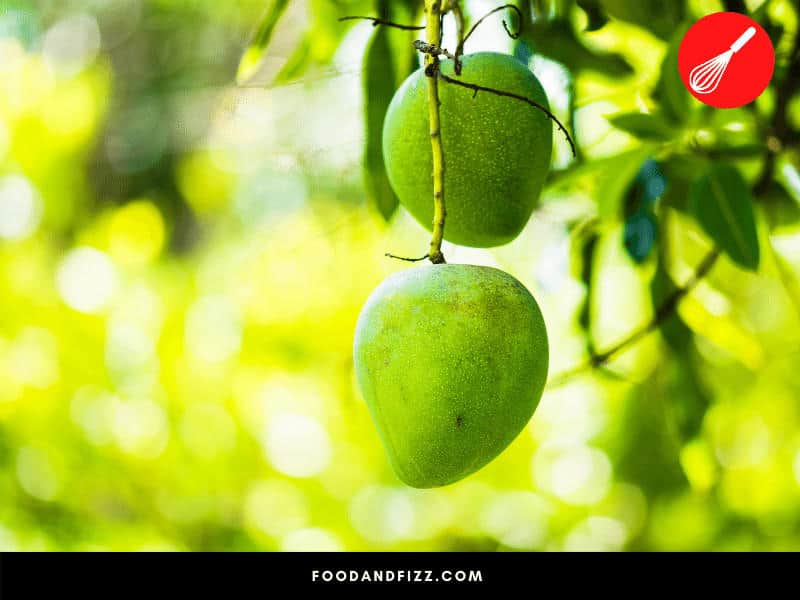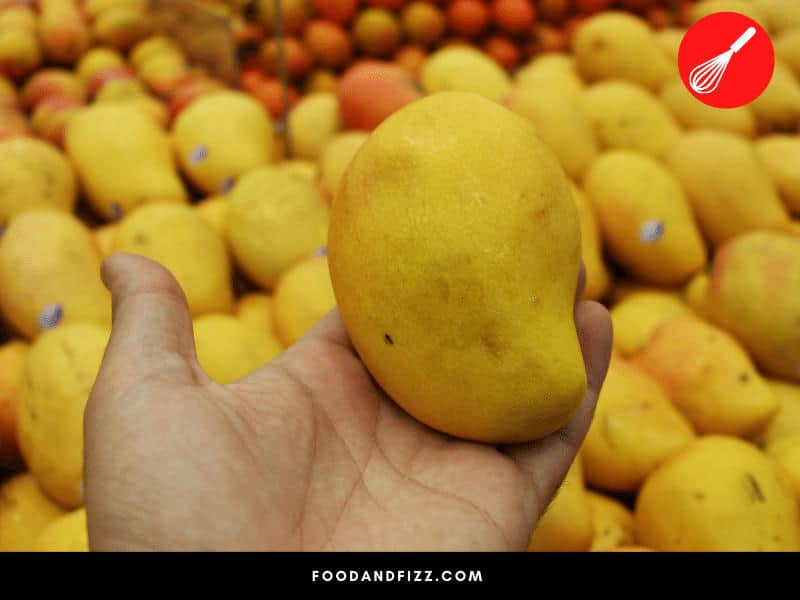Folks generally enjoy mango at various stages of its ripeness. For me, I can’t stand a sharp, hard, nearly unripe mango. For my dad, of blessed memory, that was his idea of mango heaven.
People who fall on my side of the divide only want to eat a sweet, soft, juicy, ripe mango that bursts as teeth pierce its skin, and the mango enthusiastically sprays gooey liquid pleasure everywhere. However, we all draw the line at mangoes that fizz because they always look just plain weird.
Why is My Mango Fizzy?
Your mango is fizzy because trapped carbon dioxide from fermentation is escaping from the mango. The mango is spoilt. Microorganisms have entered the mango in huge numbers, and they have been at work long enough to convert the mango’s sugars into alcohol and carbon dioxide.

Before the Fizz–This Is Why Mangoes Ripen
Mangoes (and all other sweet fruit) contain an inactive enzyme that does nothing while the mango grows on the tree.
However, once the mango falls off, or is picked by humans for their own purposes, this enzyme springs into action, adding water to starch molecules in the mango to create monosaccharides (think, saccharine, meaning sweet).
Of course, monosaccharides are sugars, and the longer the enzymes have to work their magic before they are all used up, the more sugar they produce. The more sugar the enzymes produce, the sweeter (we humans say, “riper“) the mango.
This is all very nice and everything, but of course, there are always freeloaders hoping to hone in on the action whenever someone or something is creating free organic sugars, and in the case of mangoes, those freeloading interlopers are microorganisms and bacteria.
From a human viewpoint, the best thing that could happen is that all the enzymes get used up, turning starch into sugar, and someone comes along and buys or eats a perfectly ripened mango.
This perfect, utopian outcome is possible but improbable. What is far more likely is that those pesky microorganisms find their way into the mango (most often through bruised/damaged skin), and straightaway, these rampaging little hooligans get to work feasting on the mango’s undefended sugars.

Same Thing, But Two Outcomes–When Bugs Get to the Sugars in Mangoes
Microorganisms and bacteria are extremely good at two things, gorging and feasting when unchecked and reproducing themselves. I guess that for lucky bacteria, life is one long orgy.
The trouble is, “what goes in must come out,” as the saying goes, and it’s no different for bacteria. All that feasting and gorging results in waste products, and these are quite interesting when looking at the effect of microorganisms on sweet fruits.
Where you and I and all humans excrete stool and urine from our gastronomic exertions, the little bugs in mangoes and other sweet fruits that chomp down on the fruits’ sugars produce two unexpected chemicals; alcohol and carbon dioxide.
If you allow it, I’ll temporarily switch to British English: “When these germs do their stuff and produce alcohol, humans either get pissed or pissed off.”
You see, in the UK, “pissed” means “drunk”, and “pissed off” means “angry”. In effect, I’m saying that when these little critters get going and metabolize mango sugar into alcohol, we humans either use it to our advantage to produce an alcoholic beverage or get frustrated and upset.
That’s because we aren’t looking for an alcoholic high; we are looking for an easy snack.
Fermentation and Fizzing in Mangoes
Fermentation in Mangoes
No doubt you recognize that I described the fermentation process in the previous paragraph because that is precisely what we call it when microorganisms turn sugar into alcohol.
“Fermentation” is also what we call it when microorganisms like yeast and bacteria break down starch or sugar to produce lactic acid rather than alcohol, so not all fermentation leads to booze and good times.
The difference is, boozy fermentation takes place when there is oxygen available and oxygen-breathing bugs are at work, whereas the lactic acid type of fermentation takes place when there is no oxygen and anaerobic bugs are undertaking the process of fermentation.
Fizzing in Mangoes
You’ve probably worked out by now that when fruits undergo fermentation, one of the by-products of the process is carbon dioxide, which is a gas. Naturally, gases don’t sit trapped in solids if they can help it, and carbon dioxide is no different.
As soon as microorganisms produce the stuff, carbon dioxide starts trying to escape into the atmosphere. If there is only a small quantity of carbon dioxide, then it will not have enough pressure to put up a good enough fight to make an actual escape. When this happens, the mango swells and is tender or “puffy” to the touch.
Later, as more and more bacteria, yeast, and sundry microorganisms get their teeth into the sugars and starches in the mango, there is enough carbon dioxide for the gas to punch its way out of the decaying fruit through one or more exits.
If the mango has been swelling for a while, the effect can be startling; there’s a single loud puff and a sudden escape of a noisome admixture of carbon dioxide and other bacterial waste gases.
On the other hand, more frequently, these gasses escape through multiple exits in small, cyclical build-ups, like small volcanic eruptions. This is what gives the mango its appearance of fizzing.

Tips and Tricks for Purchasing, Handling, and Eating Mangoes
1. “Puffy” or bloated mangoes result from a build-up of trapped carbon dioxide from the process of fermentation which has already started in the mango. As such, any mango that has this characteristic is close to, or already, spoilt. Don’t buy them.

2. Yeast and bacteria, the natural producers of fermentation and spoilage in mango, first enter the fruit through bruised, broken skin. Therefore, when buying mangoes, look for any signs of bruising.
If you spot any, do yourself a solid and fergit it. (You might want to take a punt if, upon pressing the bruise site gently, you can tell that the mango is still firm. This is an indication of a minor, surface-level injury only.)
3. Although fizziness is not a guarantee of illness if anyone eats the fruit, it is certainly no badge of healthy freshness either. All sorts of bacteria cause food poisoning.
As there is no way to tell the difference between fizziness caused by neutral bacteria from fizziness caused by harmful bacteria, I don’t see the point in taking a chance. Besides…
4. Fizzy mangoes aren’t sweet; how can they be when most of their sugars have been metabolized by the invading microorganisms? Fizzy mangoes are also sour because of the trapped carbon dioxide and lactic acid, which might also be present.
Both substances can cause other unpleasant effects, such as when carbon dioxide gets forced into the nasal cavity and causes a feeling of a stuffed-up nose and biliousness.
5. There is enough alcohol in fizzy mango to make it haram (forbidden) for devout Muslims. Interestingly, a distinction is made between lactic fermentation, which is halal (or allowed), and alcohol fermentation, which is haram.

Afterword: Why is My Mango Fizzy?
“Fizzing” in mangoes is a visual effect caused by escaping carbon dioxide and other gaseous waste released by the metabolic activity of microorganisms on the mango.
Sweet fruits like mangoes, blueberries, strawberries, pineapples, etc., all contain enough sugars to attract the attention of hoards of bacteria, yeast, and other microscopic creatures that can cause fizzing.
Frequently Asked Questions to Why is My Mango Fizzy?
Can You Eat Fizzy Mango?
Fizzy mangoes are a sign that the mango is not fresh and has begun to spoil. Eating a fizzy mango increases the risk of being exposed to bacteria and microorganisms that cause food-borne illnesses.
Why Is My Mango Making Noise?
When fruits undergo fermentation, carbon dioxide is produced along with other bacterial gases. The mango makes noise as trapped carbon dioxide escapes.

